HI5019: Strategic Information Systems Report - Bell Studio
VerifiedAdded on 2023/03/17
|19
|3347
|20
Report
AI Summary
This report provides a comprehensive overview of strategic information systems for businesses and enterprises, focusing on key areas such as e-commerce, financial reporting, transaction cycles, and management reporting systems. It explores the importance of accurate and timely financial information for decision-making, detailing the components and benefits of financial reporting. The report also examines different types of transaction cycles, including payroll, purchasing, sales, and financing cycles. It highlights the features and types of e-commerce, its advantages, and potential risks. Furthermore, the document includes data flow diagrams and flowcharts of various systems like purchases, cash disbursements, and payroll, followed by an analysis of potential weaknesses and risks within these systems. The report concludes with a discussion of internal control practices, their weaknesses, and associated risks, encompassing review and reconciliation, asset security, separation of duties, and authorization processes. This analysis is crucial for understanding and mitigating potential issues within business operations.
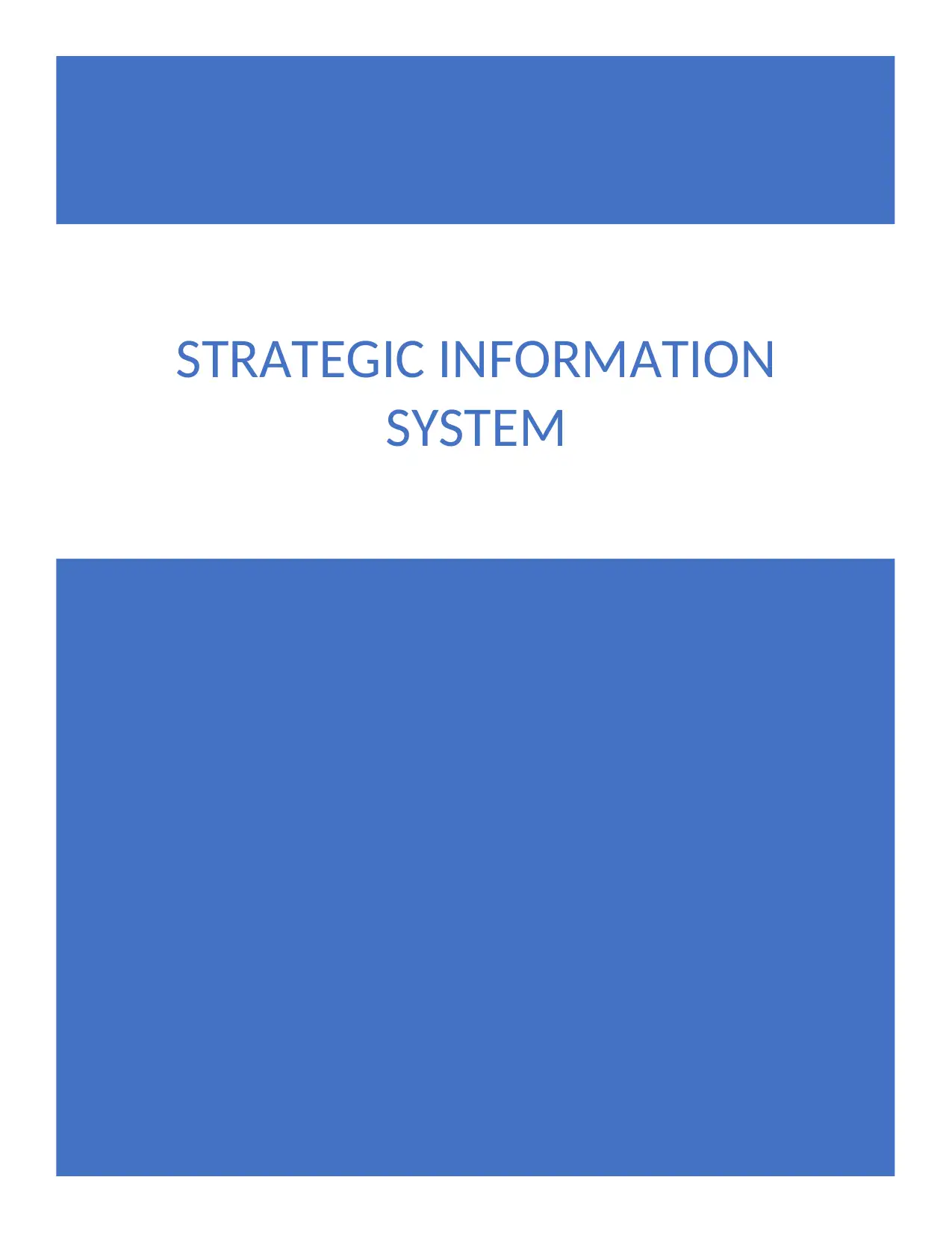
STRATEGIC INFORMATION
SYSTEM
SYSTEM
Secure Best Marks with AI Grader
Need help grading? Try our AI Grader for instant feedback on your assignments.
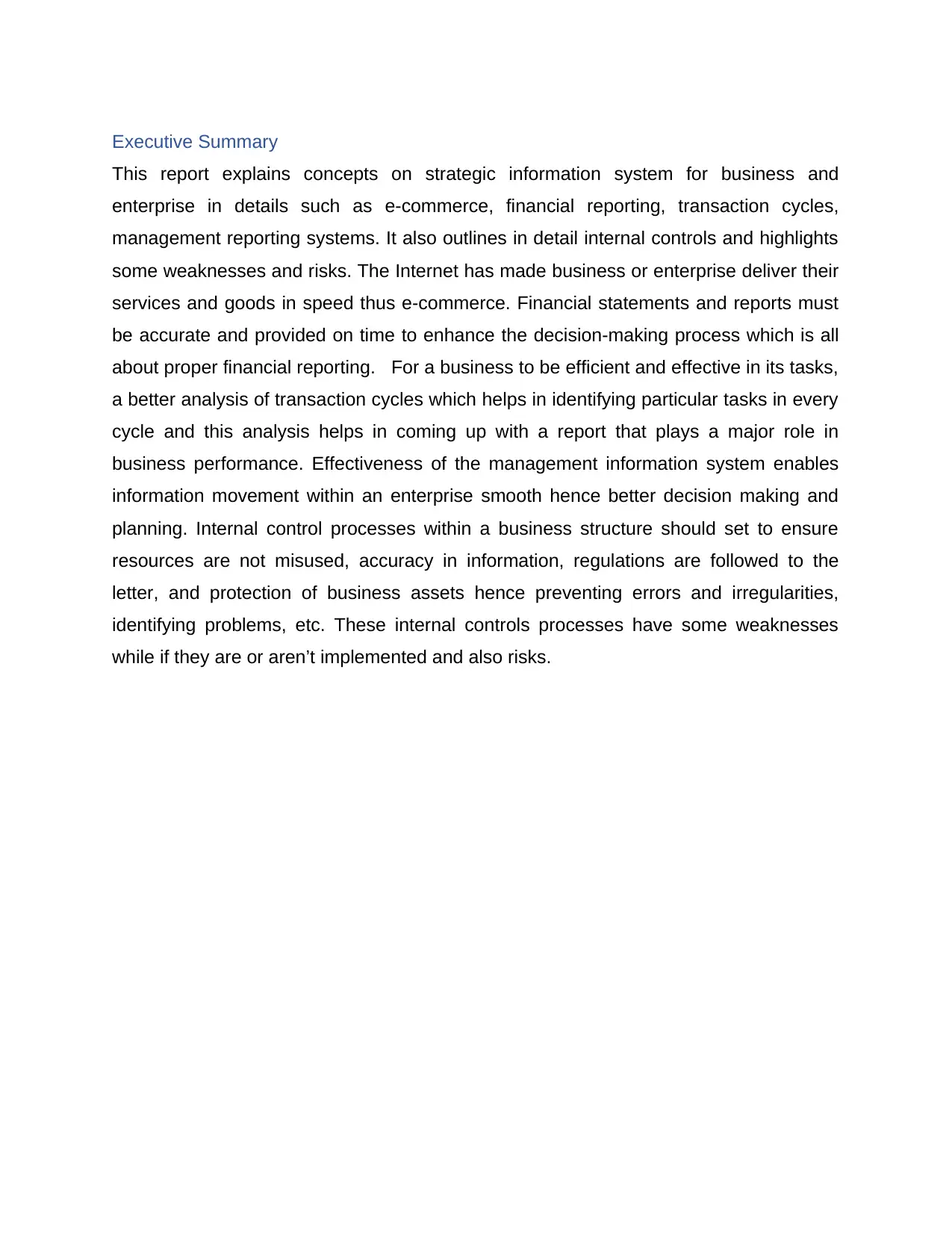
Executive Summary
This report explains concepts on strategic information system for business and
enterprise in details such as e-commerce, financial reporting, transaction cycles,
management reporting systems. It also outlines in detail internal controls and highlights
some weaknesses and risks. The Internet has made business or enterprise deliver their
services and goods in speed thus e-commerce. Financial statements and reports must
be accurate and provided on time to enhance the decision-making process which is all
about proper financial reporting. For a business to be efficient and effective in its tasks,
a better analysis of transaction cycles which helps in identifying particular tasks in every
cycle and this analysis helps in coming up with a report that plays a major role in
business performance. Effectiveness of the management information system enables
information movement within an enterprise smooth hence better decision making and
planning. Internal control processes within a business structure should set to ensure
resources are not misused, accuracy in information, regulations are followed to the
letter, and protection of business assets hence preventing errors and irregularities,
identifying problems, etc. These internal controls processes have some weaknesses
while if they are or aren’t implemented and also risks.
This report explains concepts on strategic information system for business and
enterprise in details such as e-commerce, financial reporting, transaction cycles,
management reporting systems. It also outlines in detail internal controls and highlights
some weaknesses and risks. The Internet has made business or enterprise deliver their
services and goods in speed thus e-commerce. Financial statements and reports must
be accurate and provided on time to enhance the decision-making process which is all
about proper financial reporting. For a business to be efficient and effective in its tasks,
a better analysis of transaction cycles which helps in identifying particular tasks in every
cycle and this analysis helps in coming up with a report that plays a major role in
business performance. Effectiveness of the management information system enables
information movement within an enterprise smooth hence better decision making and
planning. Internal control processes within a business structure should set to ensure
resources are not misused, accuracy in information, regulations are followed to the
letter, and protection of business assets hence preventing errors and irregularities,
identifying problems, etc. These internal controls processes have some weaknesses
while if they are or aren’t implemented and also risks.
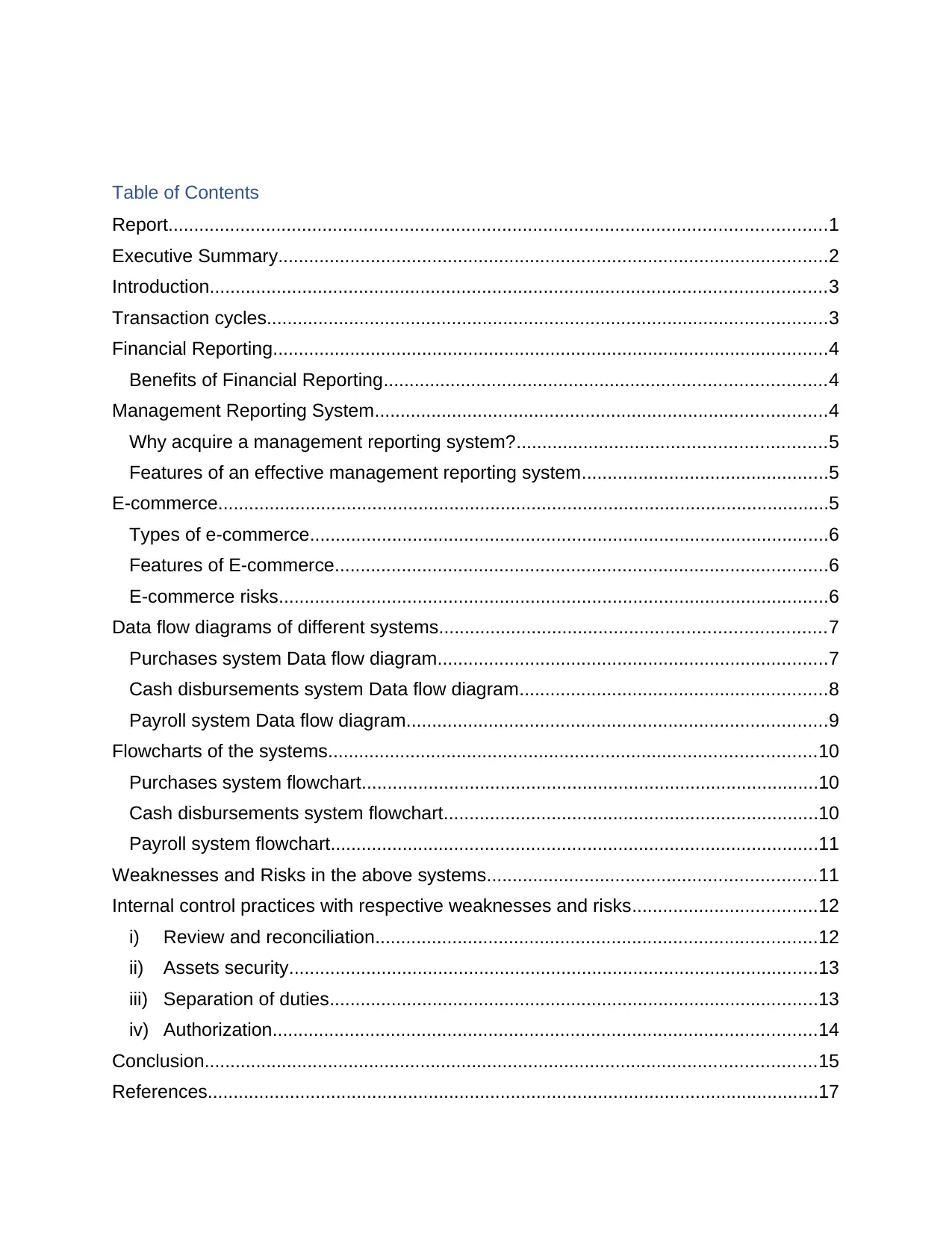
Table of Contents
Report................................................................................................................................1
Executive Summary...........................................................................................................2
Introduction........................................................................................................................3
Transaction cycles.............................................................................................................3
Financial Reporting............................................................................................................4
Benefits of Financial Reporting......................................................................................4
Management Reporting System........................................................................................4
Why acquire a management reporting system?............................................................5
Features of an effective management reporting system................................................5
E-commerce.......................................................................................................................5
Types of e-commerce.....................................................................................................6
Features of E-commerce................................................................................................6
E-commerce risks...........................................................................................................6
Data flow diagrams of different systems...........................................................................7
Purchases system Data flow diagram............................................................................7
Cash disbursements system Data flow diagram............................................................8
Payroll system Data flow diagram..................................................................................9
Flowcharts of the systems...............................................................................................10
Purchases system flowchart.........................................................................................10
Cash disbursements system flowchart.........................................................................10
Payroll system flowchart...............................................................................................11
Weaknesses and Risks in the above systems................................................................11
Internal control practices with respective weaknesses and risks....................................12
i) Review and reconciliation......................................................................................12
ii) Assets security.......................................................................................................13
iii) Separation of duties...............................................................................................13
iv) Authorization..........................................................................................................14
Conclusion.......................................................................................................................15
References.......................................................................................................................17
Report................................................................................................................................1
Executive Summary...........................................................................................................2
Introduction........................................................................................................................3
Transaction cycles.............................................................................................................3
Financial Reporting............................................................................................................4
Benefits of Financial Reporting......................................................................................4
Management Reporting System........................................................................................4
Why acquire a management reporting system?............................................................5
Features of an effective management reporting system................................................5
E-commerce.......................................................................................................................5
Types of e-commerce.....................................................................................................6
Features of E-commerce................................................................................................6
E-commerce risks...........................................................................................................6
Data flow diagrams of different systems...........................................................................7
Purchases system Data flow diagram............................................................................7
Cash disbursements system Data flow diagram............................................................8
Payroll system Data flow diagram..................................................................................9
Flowcharts of the systems...............................................................................................10
Purchases system flowchart.........................................................................................10
Cash disbursements system flowchart.........................................................................10
Payroll system flowchart...............................................................................................11
Weaknesses and Risks in the above systems................................................................11
Internal control practices with respective weaknesses and risks....................................12
i) Review and reconciliation......................................................................................12
ii) Assets security.......................................................................................................13
iii) Separation of duties...............................................................................................13
iv) Authorization..........................................................................................................14
Conclusion.......................................................................................................................15
References.......................................................................................................................17
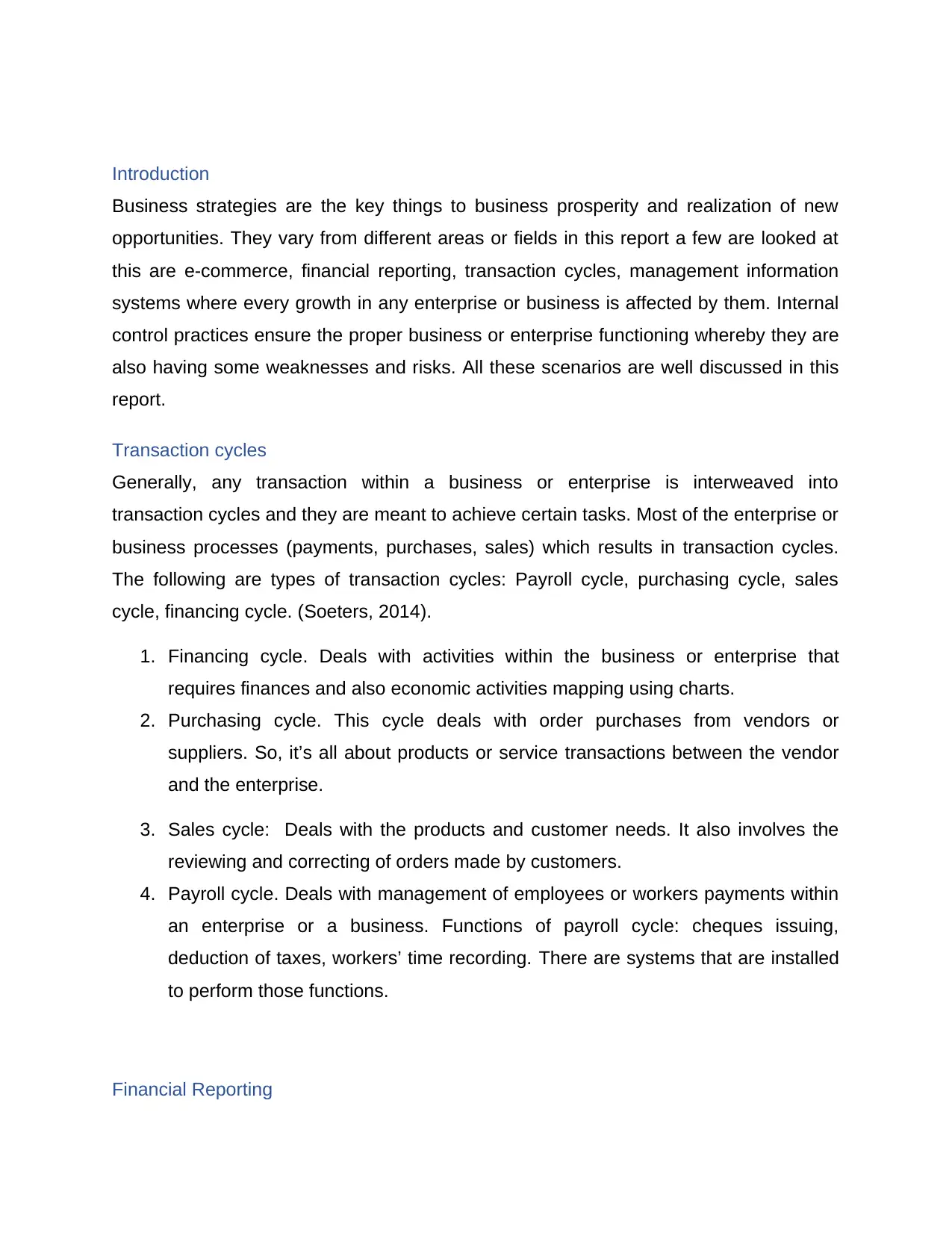
Introduction
Business strategies are the key things to business prosperity and realization of new
opportunities. They vary from different areas or fields in this report a few are looked at
this are e-commerce, financial reporting, transaction cycles, management information
systems where every growth in any enterprise or business is affected by them. Internal
control practices ensure the proper business or enterprise functioning whereby they are
also having some weaknesses and risks. All these scenarios are well discussed in this
report.
Transaction cycles
Generally, any transaction within a business or enterprise is interweaved into
transaction cycles and they are meant to achieve certain tasks. Most of the enterprise or
business processes (payments, purchases, sales) which results in transaction cycles.
The following are types of transaction cycles: Payroll cycle, purchasing cycle, sales
cycle, financing cycle. (Soeters, 2014).
1. Financing cycle. Deals with activities within the business or enterprise that
requires finances and also economic activities mapping using charts.
2. Purchasing cycle. This cycle deals with order purchases from vendors or
suppliers. So, it’s all about products or service transactions between the vendor
and the enterprise.
3. Sales cycle: Deals with the products and customer needs. It also involves the
reviewing and correcting of orders made by customers.
4. Payroll cycle. Deals with management of employees or workers payments within
an enterprise or a business. Functions of payroll cycle: cheques issuing,
deduction of taxes, workers’ time recording. There are systems that are installed
to perform those functions.
Financial Reporting
Business strategies are the key things to business prosperity and realization of new
opportunities. They vary from different areas or fields in this report a few are looked at
this are e-commerce, financial reporting, transaction cycles, management information
systems where every growth in any enterprise or business is affected by them. Internal
control practices ensure the proper business or enterprise functioning whereby they are
also having some weaknesses and risks. All these scenarios are well discussed in this
report.
Transaction cycles
Generally, any transaction within a business or enterprise is interweaved into
transaction cycles and they are meant to achieve certain tasks. Most of the enterprise or
business processes (payments, purchases, sales) which results in transaction cycles.
The following are types of transaction cycles: Payroll cycle, purchasing cycle, sales
cycle, financing cycle. (Soeters, 2014).
1. Financing cycle. Deals with activities within the business or enterprise that
requires finances and also economic activities mapping using charts.
2. Purchasing cycle. This cycle deals with order purchases from vendors or
suppliers. So, it’s all about products or service transactions between the vendor
and the enterprise.
3. Sales cycle: Deals with the products and customer needs. It also involves the
reviewing and correcting of orders made by customers.
4. Payroll cycle. Deals with management of employees or workers payments within
an enterprise or a business. Functions of payroll cycle: cheques issuing,
deduction of taxes, workers’ time recording. There are systems that are installed
to perform those functions.
Financial Reporting
Secure Best Marks with AI Grader
Need help grading? Try our AI Grader for instant feedback on your assignments.
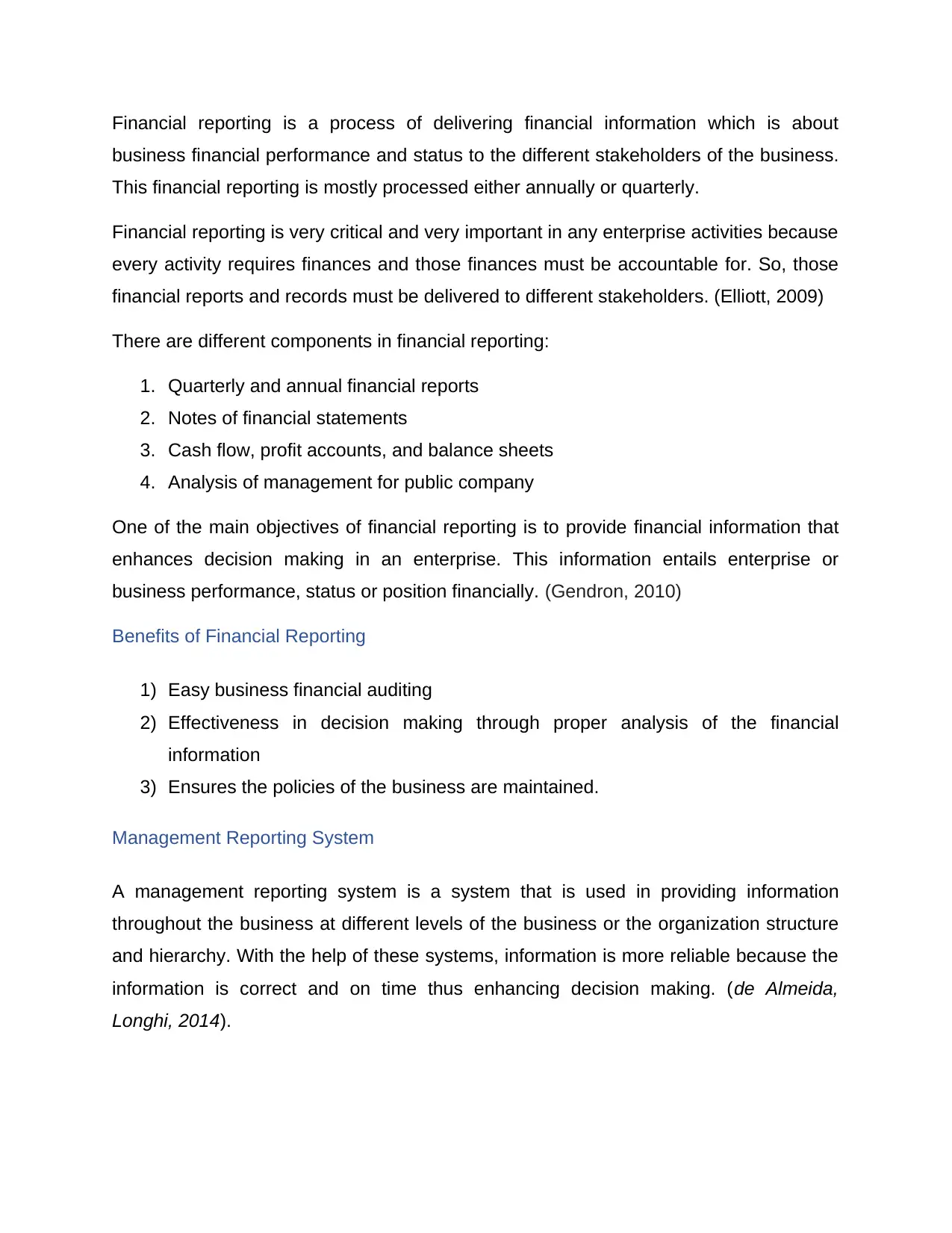
Financial reporting is a process of delivering financial information which is about
business financial performance and status to the different stakeholders of the business.
This financial reporting is mostly processed either annually or quarterly.
Financial reporting is very critical and very important in any enterprise activities because
every activity requires finances and those finances must be accountable for. So, those
financial reports and records must be delivered to different stakeholders. (Elliott, 2009)
There are different components in financial reporting:
1. Quarterly and annual financial reports
2. Notes of financial statements
3. Cash flow, profit accounts, and balance sheets
4. Analysis of management for public company
One of the main objectives of financial reporting is to provide financial information that
enhances decision making in an enterprise. This information entails enterprise or
business performance, status or position financially. (Gendron, 2010)
Benefits of Financial Reporting
1) Easy business financial auditing
2) Effectiveness in decision making through proper analysis of the financial
information
3) Ensures the policies of the business are maintained.
Management Reporting System
A management reporting system is a system that is used in providing information
throughout the business at different levels of the business or the organization structure
and hierarchy. With the help of these systems, information is more reliable because the
information is correct and on time thus enhancing decision making. (de Almeida,
Longhi, 2014).
business financial performance and status to the different stakeholders of the business.
This financial reporting is mostly processed either annually or quarterly.
Financial reporting is very critical and very important in any enterprise activities because
every activity requires finances and those finances must be accountable for. So, those
financial reports and records must be delivered to different stakeholders. (Elliott, 2009)
There are different components in financial reporting:
1. Quarterly and annual financial reports
2. Notes of financial statements
3. Cash flow, profit accounts, and balance sheets
4. Analysis of management for public company
One of the main objectives of financial reporting is to provide financial information that
enhances decision making in an enterprise. This information entails enterprise or
business performance, status or position financially. (Gendron, 2010)
Benefits of Financial Reporting
1) Easy business financial auditing
2) Effectiveness in decision making through proper analysis of the financial
information
3) Ensures the policies of the business are maintained.
Management Reporting System
A management reporting system is a system that is used in providing information
throughout the business at different levels of the business or the organization structure
and hierarchy. With the help of these systems, information is more reliable because the
information is correct and on time thus enhancing decision making. (de Almeida,
Longhi, 2014).
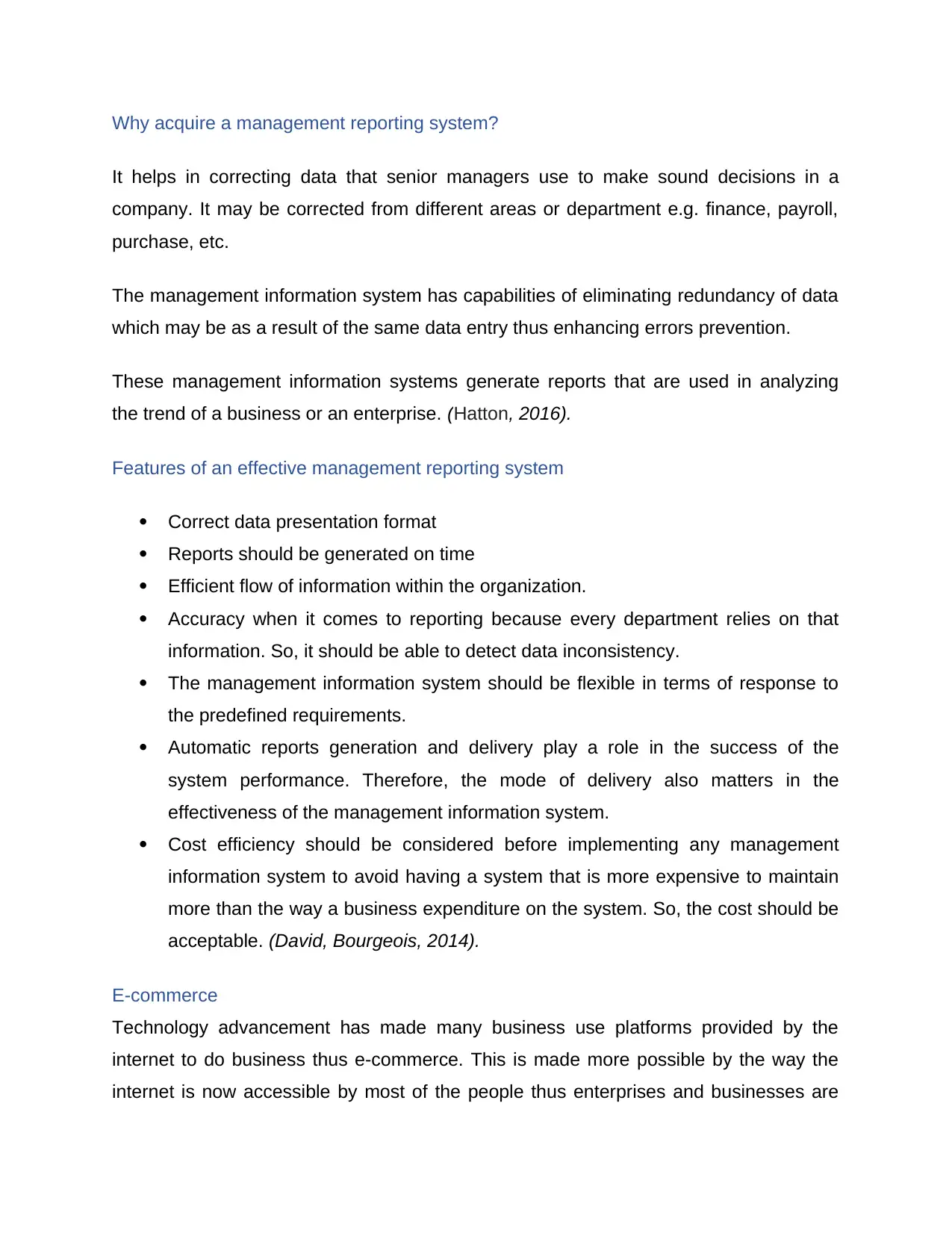
Why acquire a management reporting system?
It helps in correcting data that senior managers use to make sound decisions in a
company. It may be corrected from different areas or department e.g. finance, payroll,
purchase, etc.
The management information system has capabilities of eliminating redundancy of data
which may be as a result of the same data entry thus enhancing errors prevention.
These management information systems generate reports that are used in analyzing
the trend of a business or an enterprise. (Hatton, 2016).
Features of an effective management reporting system
Correct data presentation format
Reports should be generated on time
Efficient flow of information within the organization.
Accuracy when it comes to reporting because every department relies on that
information. So, it should be able to detect data inconsistency.
The management information system should be flexible in terms of response to
the predefined requirements.
Automatic reports generation and delivery play a role in the success of the
system performance. Therefore, the mode of delivery also matters in the
effectiveness of the management information system.
Cost efficiency should be considered before implementing any management
information system to avoid having a system that is more expensive to maintain
more than the way a business expenditure on the system. So, the cost should be
acceptable. (David, Bourgeois, 2014).
E-commerce
Technology advancement has made many business use platforms provided by the
internet to do business thus e-commerce. This is made more possible by the way the
internet is now accessible by most of the people thus enterprises and businesses are
It helps in correcting data that senior managers use to make sound decisions in a
company. It may be corrected from different areas or department e.g. finance, payroll,
purchase, etc.
The management information system has capabilities of eliminating redundancy of data
which may be as a result of the same data entry thus enhancing errors prevention.
These management information systems generate reports that are used in analyzing
the trend of a business or an enterprise. (Hatton, 2016).
Features of an effective management reporting system
Correct data presentation format
Reports should be generated on time
Efficient flow of information within the organization.
Accuracy when it comes to reporting because every department relies on that
information. So, it should be able to detect data inconsistency.
The management information system should be flexible in terms of response to
the predefined requirements.
Automatic reports generation and delivery play a role in the success of the
system performance. Therefore, the mode of delivery also matters in the
effectiveness of the management information system.
Cost efficiency should be considered before implementing any management
information system to avoid having a system that is more expensive to maintain
more than the way a business expenditure on the system. So, the cost should be
acceptable. (David, Bourgeois, 2014).
E-commerce
Technology advancement has made many business use platforms provided by the
internet to do business thus e-commerce. This is made more possible by the way the
internet is now accessible by most of the people thus enterprises and businesses are
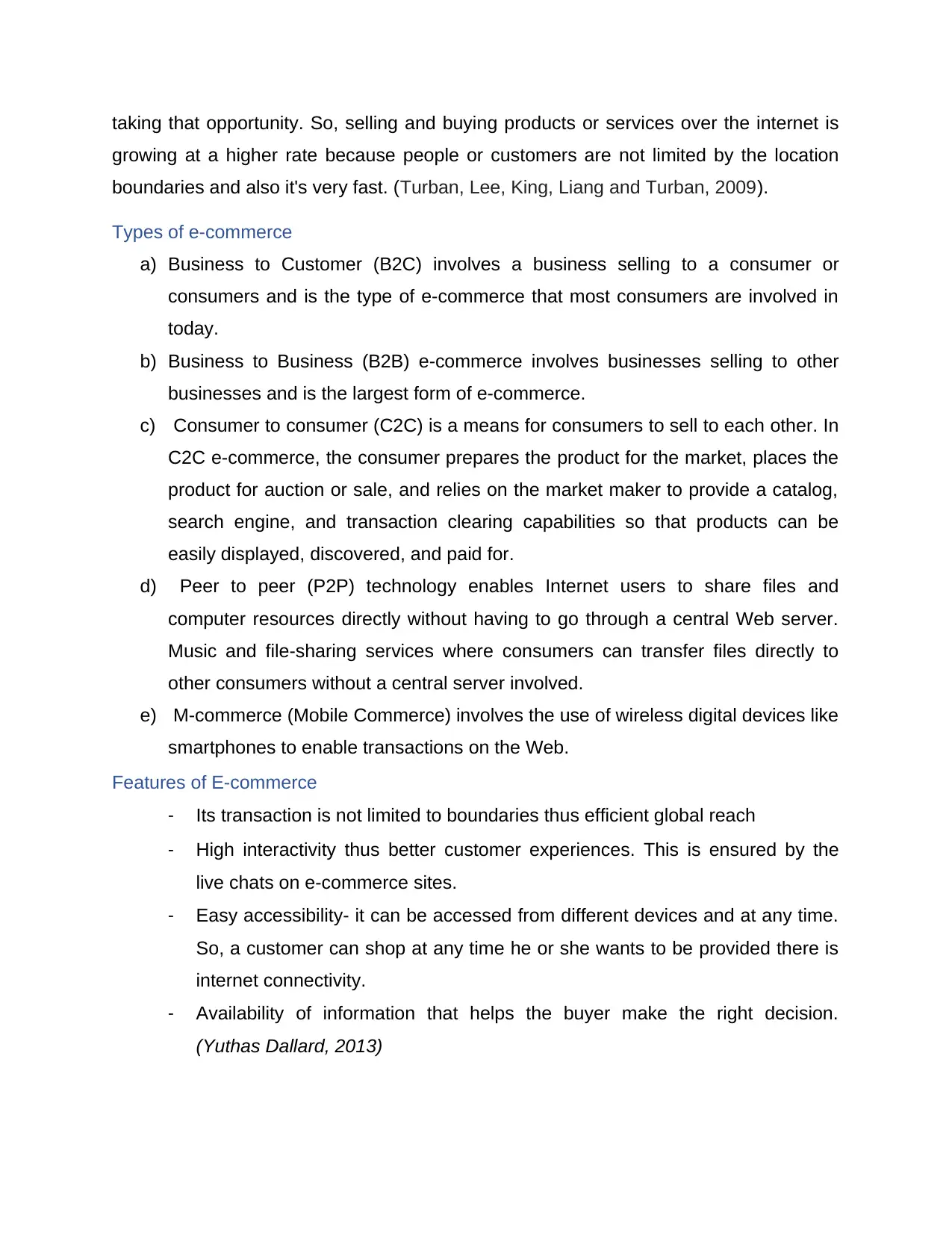
taking that opportunity. So, selling and buying products or services over the internet is
growing at a higher rate because people or customers are not limited by the location
boundaries and also it's very fast. (Turban, Lee, King, Liang and Turban, 2009).
Types of e-commerce
a) Business to Customer (B2C) involves a business selling to a consumer or
consumers and is the type of e-commerce that most consumers are involved in
today.
b) Business to Business (B2B) e-commerce involves businesses selling to other
businesses and is the largest form of e-commerce.
c) Consumer to consumer (C2C) is a means for consumers to sell to each other. In
C2C e-commerce, the consumer prepares the product for the market, places the
product for auction or sale, and relies on the market maker to provide a catalog,
search engine, and transaction clearing capabilities so that products can be
easily displayed, discovered, and paid for.
d) Peer to peer (P2P) technology enables Internet users to share files and
computer resources directly without having to go through a central Web server.
Music and file-sharing services where consumers can transfer files directly to
other consumers without a central server involved.
e) M-commerce (Mobile Commerce) involves the use of wireless digital devices like
smartphones to enable transactions on the Web.
Features of E-commerce
- Its transaction is not limited to boundaries thus efficient global reach
- High interactivity thus better customer experiences. This is ensured by the
live chats on e-commerce sites.
- Easy accessibility- it can be accessed from different devices and at any time.
So, a customer can shop at any time he or she wants to be provided there is
internet connectivity.
- Availability of information that helps the buyer make the right decision.
(Yuthas Dallard, 2013)
growing at a higher rate because people or customers are not limited by the location
boundaries and also it's very fast. (Turban, Lee, King, Liang and Turban, 2009).
Types of e-commerce
a) Business to Customer (B2C) involves a business selling to a consumer or
consumers and is the type of e-commerce that most consumers are involved in
today.
b) Business to Business (B2B) e-commerce involves businesses selling to other
businesses and is the largest form of e-commerce.
c) Consumer to consumer (C2C) is a means for consumers to sell to each other. In
C2C e-commerce, the consumer prepares the product for the market, places the
product for auction or sale, and relies on the market maker to provide a catalog,
search engine, and transaction clearing capabilities so that products can be
easily displayed, discovered, and paid for.
d) Peer to peer (P2P) technology enables Internet users to share files and
computer resources directly without having to go through a central Web server.
Music and file-sharing services where consumers can transfer files directly to
other consumers without a central server involved.
e) M-commerce (Mobile Commerce) involves the use of wireless digital devices like
smartphones to enable transactions on the Web.
Features of E-commerce
- Its transaction is not limited to boundaries thus efficient global reach
- High interactivity thus better customer experiences. This is ensured by the
live chats on e-commerce sites.
- Easy accessibility- it can be accessed from different devices and at any time.
So, a customer can shop at any time he or she wants to be provided there is
internet connectivity.
- Availability of information that helps the buyer make the right decision.
(Yuthas Dallard, 2013)
Paraphrase This Document
Need a fresh take? Get an instant paraphrase of this document with our AI Paraphraser
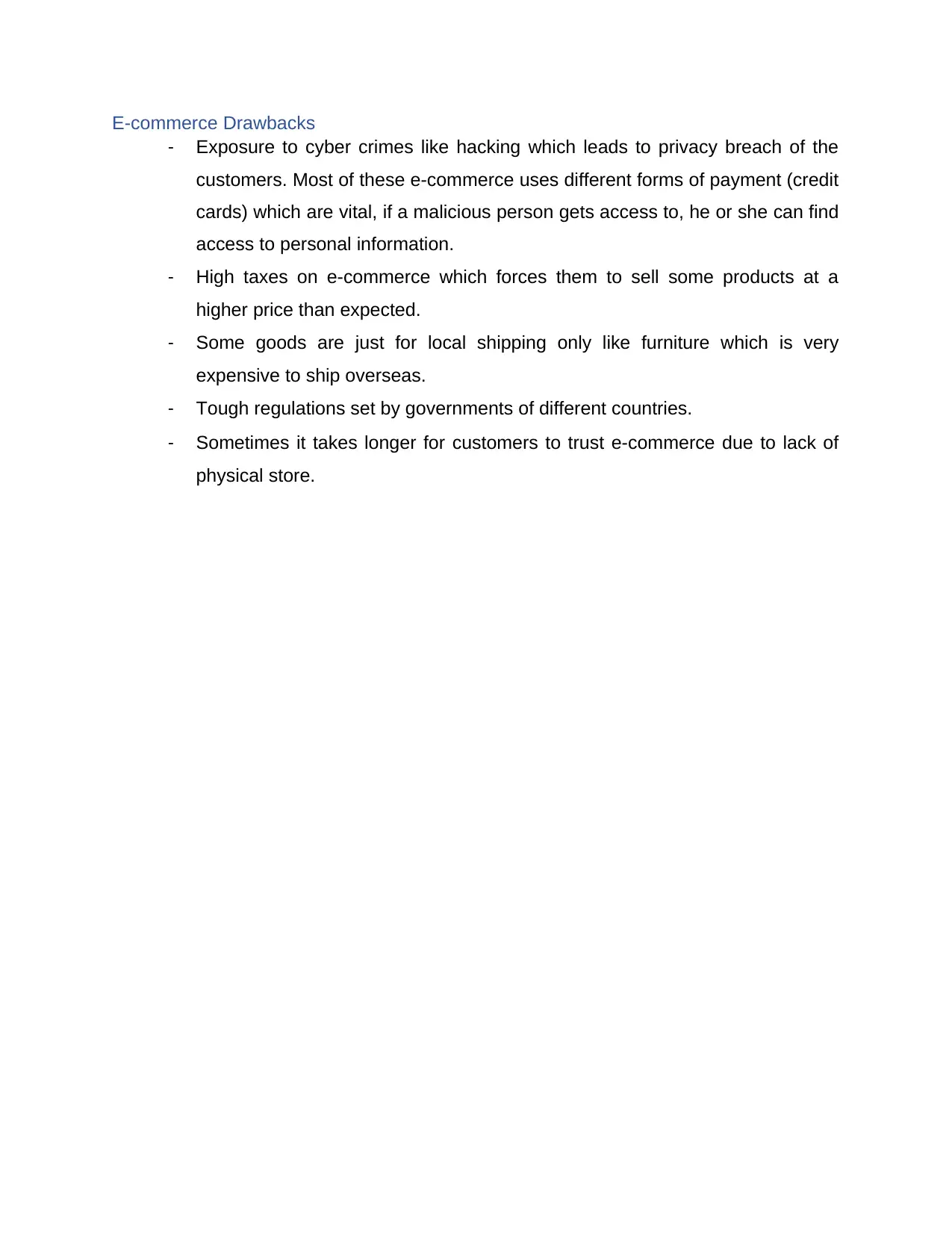
E-commerce Drawbacks
- Exposure to cyber crimes like hacking which leads to privacy breach of the
customers. Most of these e-commerce uses different forms of payment (credit
cards) which are vital, if a malicious person gets access to, he or she can find
access to personal information.
- High taxes on e-commerce which forces them to sell some products at a
higher price than expected.
- Some goods are just for local shipping only like furniture which is very
expensive to ship overseas.
- Tough regulations set by governments of different countries.
- Sometimes it takes longer for customers to trust e-commerce due to lack of
physical store.
- Exposure to cyber crimes like hacking which leads to privacy breach of the
customers. Most of these e-commerce uses different forms of payment (credit
cards) which are vital, if a malicious person gets access to, he or she can find
access to personal information.
- High taxes on e-commerce which forces them to sell some products at a
higher price than expected.
- Some goods are just for local shipping only like furniture which is very
expensive to ship overseas.
- Tough regulations set by governments of different countries.
- Sometimes it takes longer for customers to trust e-commerce due to lack of
physical store.
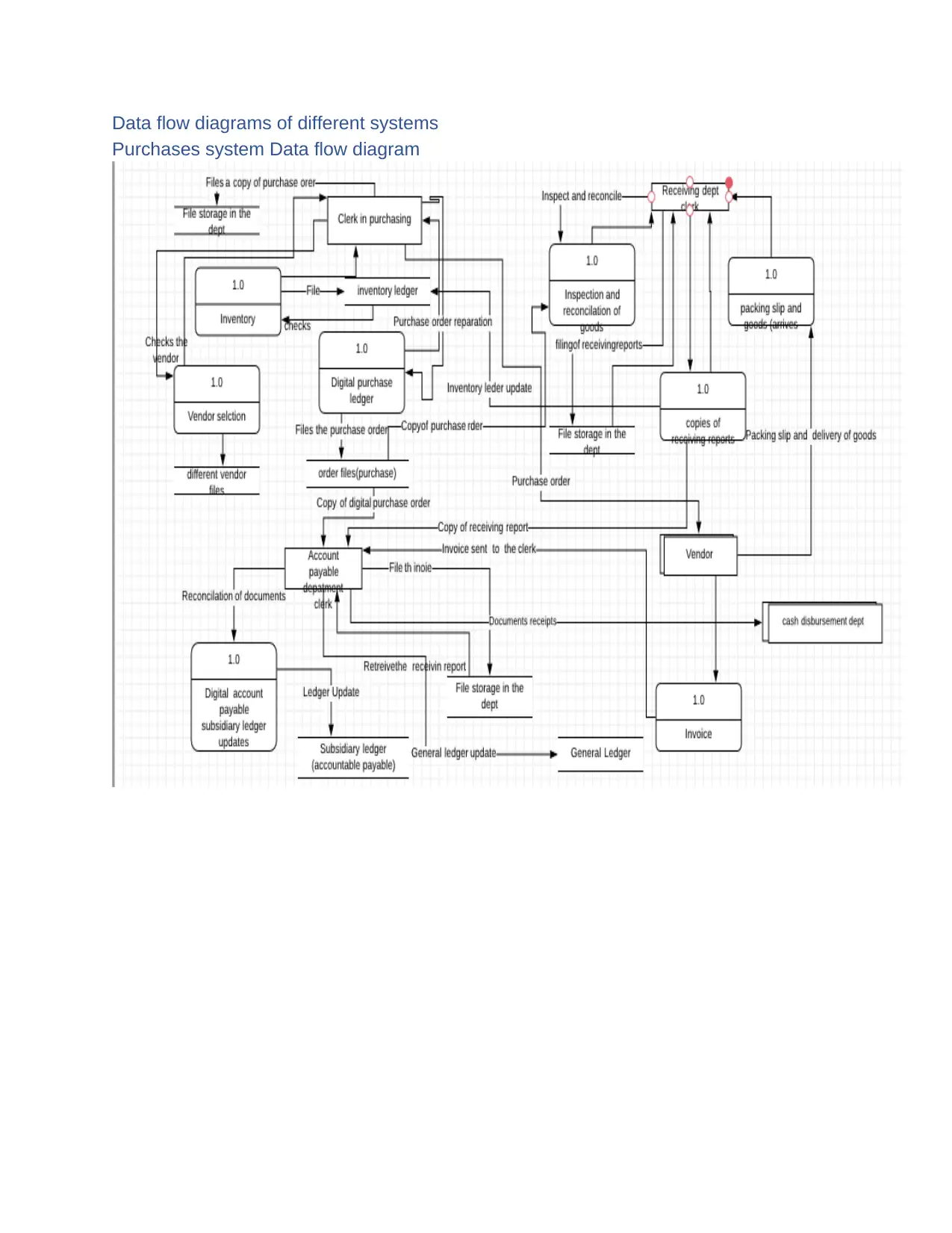
Data flow diagrams of different systems
Purchases system Data flow diagram
Purchases system Data flow diagram
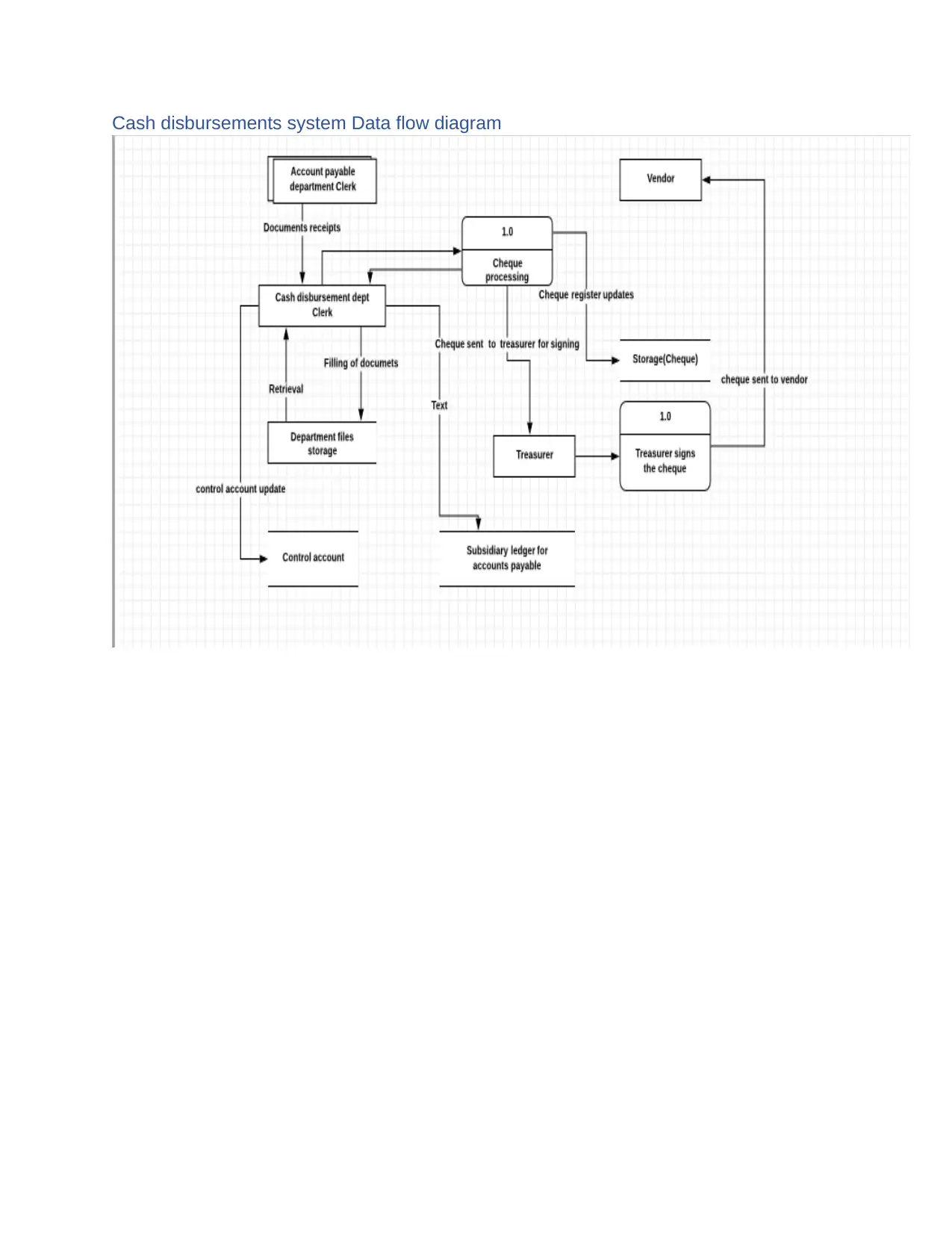
Cash disbursements system Data flow diagram
Secure Best Marks with AI Grader
Need help grading? Try our AI Grader for instant feedback on your assignments.
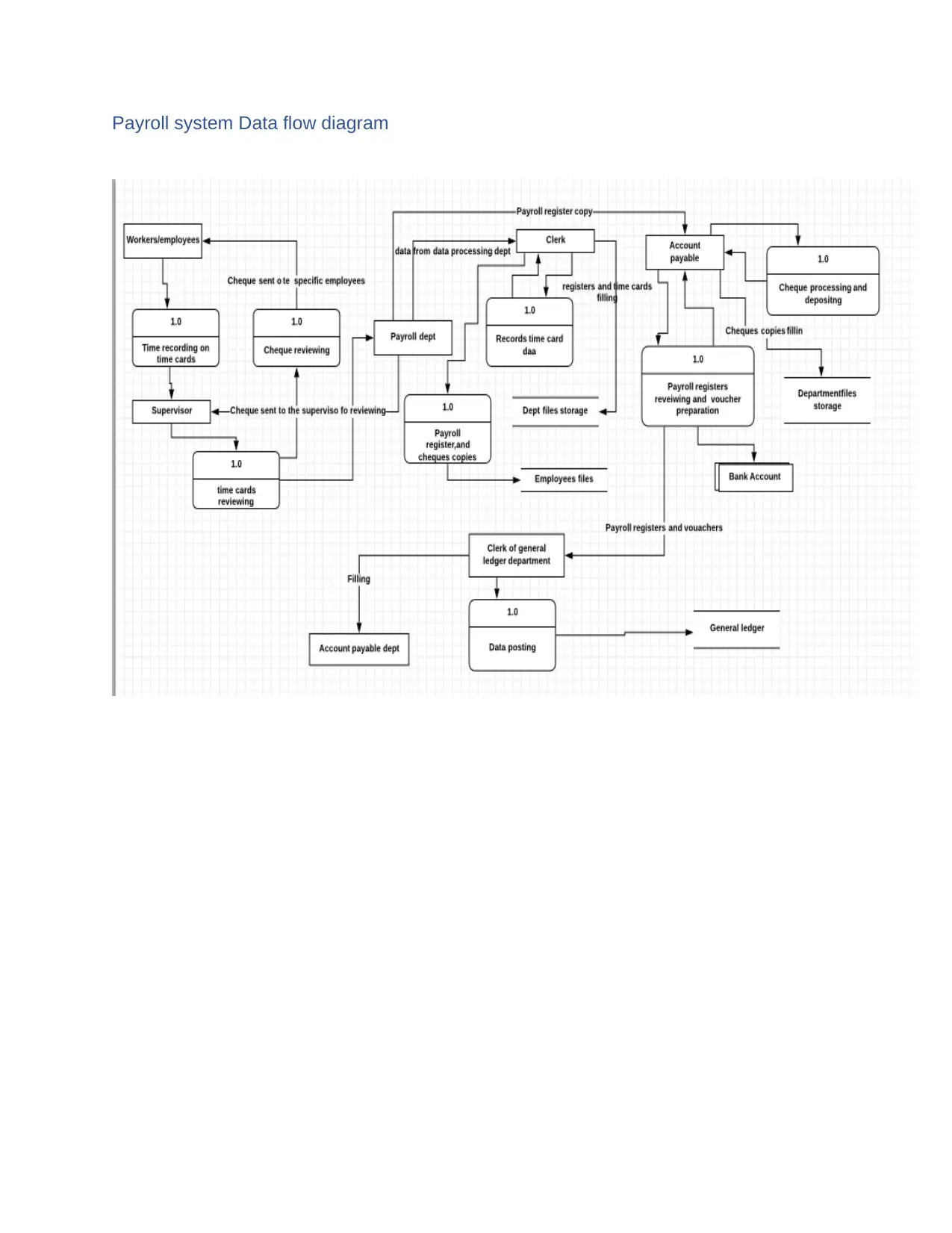
Payroll system Data flow diagram
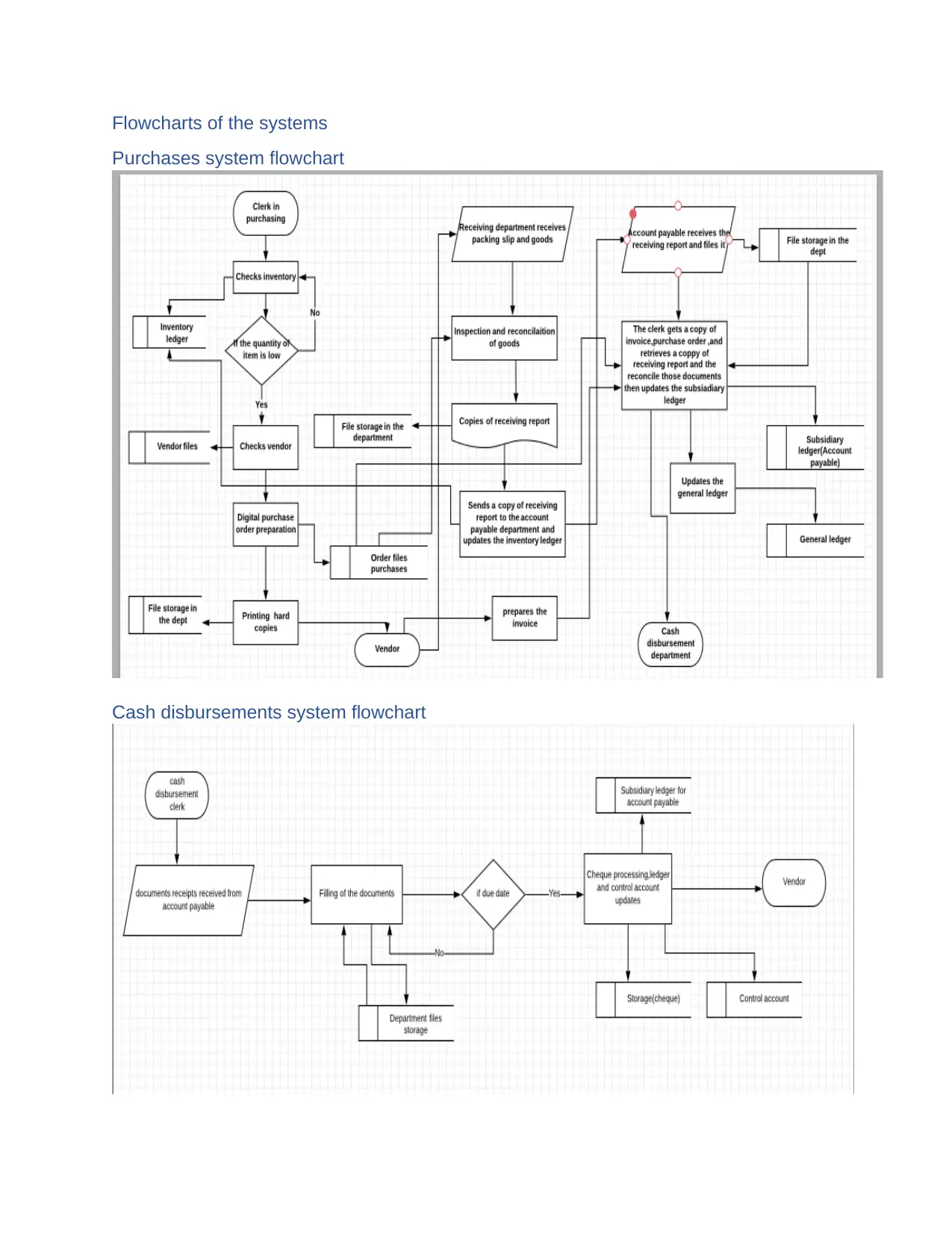
Flowcharts of the systems
Purchases system flowchart
Cash disbursements system flowchart
Purchases system flowchart
Cash disbursements system flowchart

Payroll system flowchart
Weaknesses and Risks in the above systems
Weaknesses may result in a negative impact on the growth of the enterprise or
business. From the above-highlighted systems, the following weaknesses are identified
and how they affect the functioning of the business: (Pathak, 2015)
a) Purchases system:
i. Everything starts with the clerk that is the processes depends on the clerk to
check the inventory if certain goods are low in quantity. So, the problem
arises when the clerk of the purchase system fails to check and identify a
particular item is running low. Also, the clerk may fail to deliver the purchase
order to the vendor on time which may result to delay of the item being
supplied where it also may affect the cash disbursement department
processes.
Weaknesses and Risks in the above systems
Weaknesses may result in a negative impact on the growth of the enterprise or
business. From the above-highlighted systems, the following weaknesses are identified
and how they affect the functioning of the business: (Pathak, 2015)
a) Purchases system:
i. Everything starts with the clerk that is the processes depends on the clerk to
check the inventory if certain goods are low in quantity. So, the problem
arises when the clerk of the purchase system fails to check and identify a
particular item is running low. Also, the clerk may fail to deliver the purchase
order to the vendor on time which may result to delay of the item being
supplied where it also may affect the cash disbursement department
processes.
Paraphrase This Document
Need a fresh take? Get an instant paraphrase of this document with our AI Paraphraser
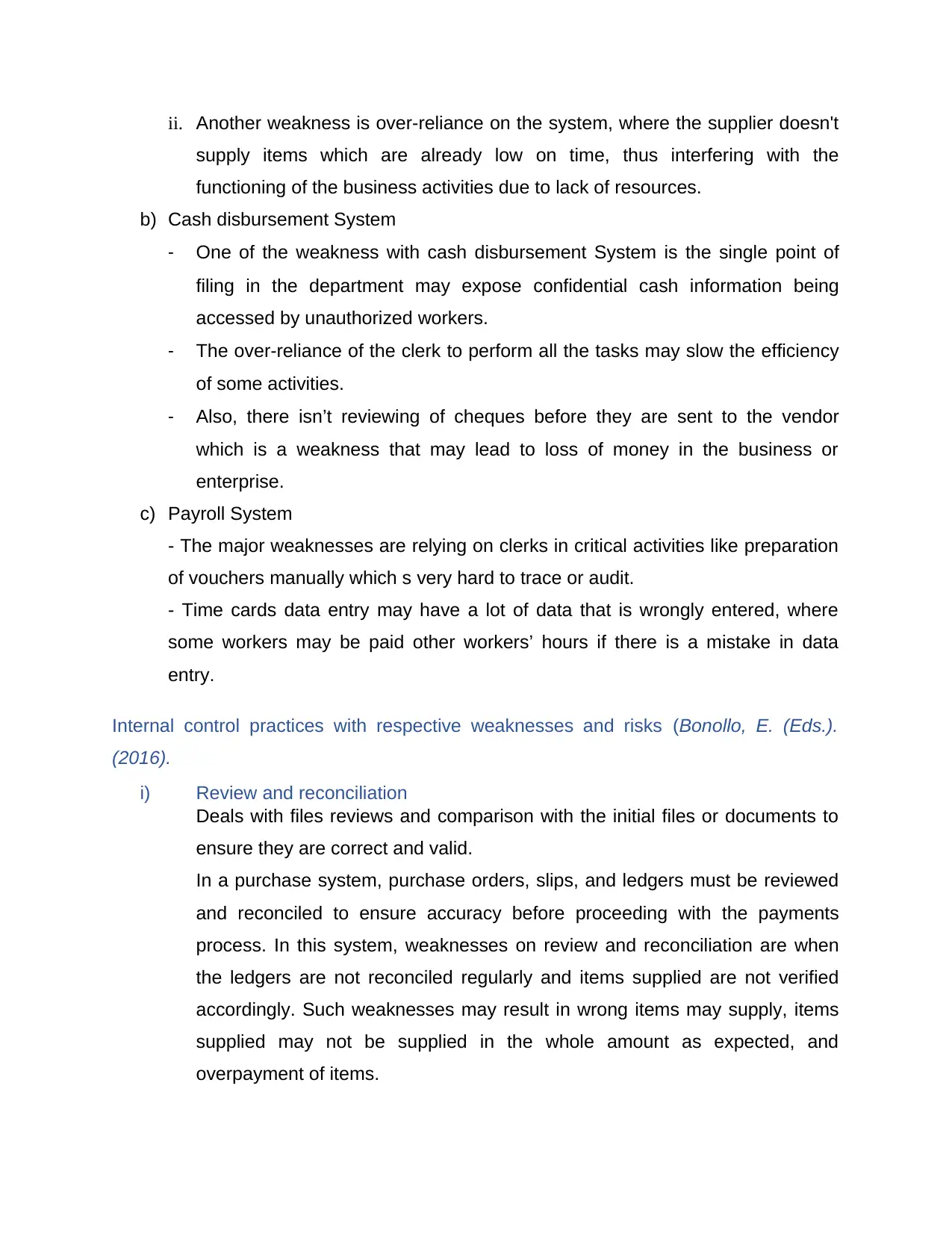
ii. Another weakness is over-reliance on the system, where the supplier doesn't
supply items which are already low on time, thus interfering with the
functioning of the business activities due to lack of resources.
b) Cash disbursement System
- One of the weakness with cash disbursement System is the single point of
filing in the department may expose confidential cash information being
accessed by unauthorized workers.
- The over-reliance of the clerk to perform all the tasks may slow the efficiency
of some activities.
- Also, there isn’t reviewing of cheques before they are sent to the vendor
which is a weakness that may lead to loss of money in the business or
enterprise.
c) Payroll System
- The major weaknesses are relying on clerks in critical activities like preparation
of vouchers manually which s very hard to trace or audit.
- Time cards data entry may have a lot of data that is wrongly entered, where
some workers may be paid other workers’ hours if there is a mistake in data
entry.
Internal control practices with respective weaknesses and risks (Bonollo, E. (Eds.).
(2016).
i) Review and reconciliation
Deals with files reviews and comparison with the initial files or documents to
ensure they are correct and valid.
In a purchase system, purchase orders, slips, and ledgers must be reviewed
and reconciled to ensure accuracy before proceeding with the payments
process. In this system, weaknesses on review and reconciliation are when
the ledgers are not reconciled regularly and items supplied are not verified
accordingly. Such weaknesses may result in wrong items may supply, items
supplied may not be supplied in the whole amount as expected, and
overpayment of items.
supply items which are already low on time, thus interfering with the
functioning of the business activities due to lack of resources.
b) Cash disbursement System
- One of the weakness with cash disbursement System is the single point of
filing in the department may expose confidential cash information being
accessed by unauthorized workers.
- The over-reliance of the clerk to perform all the tasks may slow the efficiency
of some activities.
- Also, there isn’t reviewing of cheques before they are sent to the vendor
which is a weakness that may lead to loss of money in the business or
enterprise.
c) Payroll System
- The major weaknesses are relying on clerks in critical activities like preparation
of vouchers manually which s very hard to trace or audit.
- Time cards data entry may have a lot of data that is wrongly entered, where
some workers may be paid other workers’ hours if there is a mistake in data
entry.
Internal control practices with respective weaknesses and risks (Bonollo, E. (Eds.).
(2016).
i) Review and reconciliation
Deals with files reviews and comparison with the initial files or documents to
ensure they are correct and valid.
In a purchase system, purchase orders, slips, and ledgers must be reviewed
and reconciled to ensure accuracy before proceeding with the payments
process. In this system, weaknesses on review and reconciliation are when
the ledgers are not reconciled regularly and items supplied are not verified
accordingly. Such weaknesses may result in wrong items may supply, items
supplied may not be supplied in the whole amount as expected, and
overpayment of items.
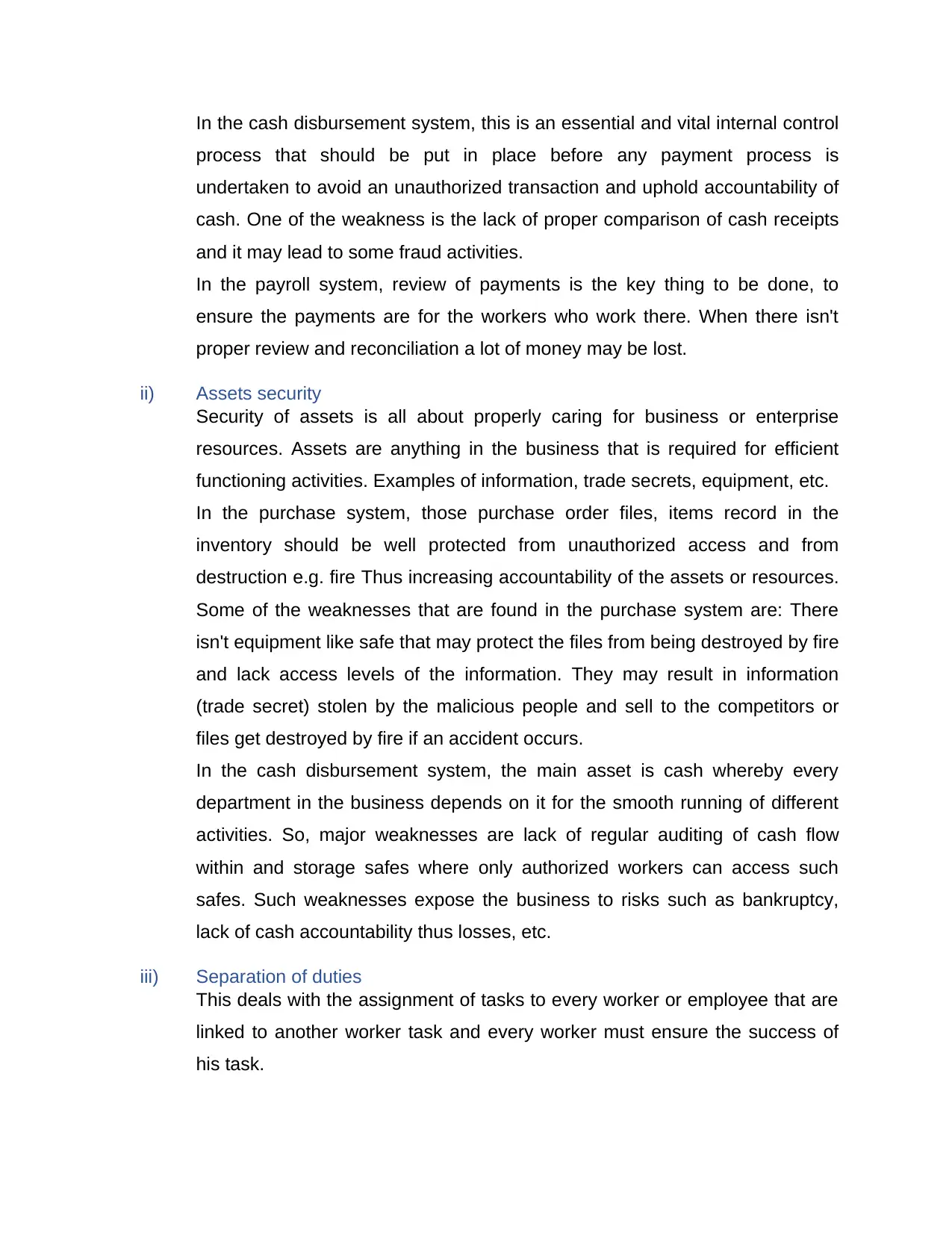
In the cash disbursement system, this is an essential and vital internal control
process that should be put in place before any payment process is
undertaken to avoid an unauthorized transaction and uphold accountability of
cash. One of the weakness is the lack of proper comparison of cash receipts
and it may lead to some fraud activities.
In the payroll system, review of payments is the key thing to be done, to
ensure the payments are for the workers who work there. When there isn't
proper review and reconciliation a lot of money may be lost.
ii) Assets security
Security of assets is all about properly caring for business or enterprise
resources. Assets are anything in the business that is required for efficient
functioning activities. Examples of information, trade secrets, equipment, etc.
In the purchase system, those purchase order files, items record in the
inventory should be well protected from unauthorized access and from
destruction e.g. fire Thus increasing accountability of the assets or resources.
Some of the weaknesses that are found in the purchase system are: There
isn't equipment like safe that may protect the files from being destroyed by fire
and lack access levels of the information. They may result in information
(trade secret) stolen by the malicious people and sell to the competitors or
files get destroyed by fire if an accident occurs.
In the cash disbursement system, the main asset is cash whereby every
department in the business depends on it for the smooth running of different
activities. So, major weaknesses are lack of regular auditing of cash flow
within and storage safes where only authorized workers can access such
safes. Such weaknesses expose the business to risks such as bankruptcy,
lack of cash accountability thus losses, etc.
iii) Separation of duties
This deals with the assignment of tasks to every worker or employee that are
linked to another worker task and every worker must ensure the success of
his task.
process that should be put in place before any payment process is
undertaken to avoid an unauthorized transaction and uphold accountability of
cash. One of the weakness is the lack of proper comparison of cash receipts
and it may lead to some fraud activities.
In the payroll system, review of payments is the key thing to be done, to
ensure the payments are for the workers who work there. When there isn't
proper review and reconciliation a lot of money may be lost.
ii) Assets security
Security of assets is all about properly caring for business or enterprise
resources. Assets are anything in the business that is required for efficient
functioning activities. Examples of information, trade secrets, equipment, etc.
In the purchase system, those purchase order files, items record in the
inventory should be well protected from unauthorized access and from
destruction e.g. fire Thus increasing accountability of the assets or resources.
Some of the weaknesses that are found in the purchase system are: There
isn't equipment like safe that may protect the files from being destroyed by fire
and lack access levels of the information. They may result in information
(trade secret) stolen by the malicious people and sell to the competitors or
files get destroyed by fire if an accident occurs.
In the cash disbursement system, the main asset is cash whereby every
department in the business depends on it for the smooth running of different
activities. So, major weaknesses are lack of regular auditing of cash flow
within and storage safes where only authorized workers can access such
safes. Such weaknesses expose the business to risks such as bankruptcy,
lack of cash accountability thus losses, etc.
iii) Separation of duties
This deals with the assignment of tasks to every worker or employee that are
linked to another worker task and every worker must ensure the success of
his task.
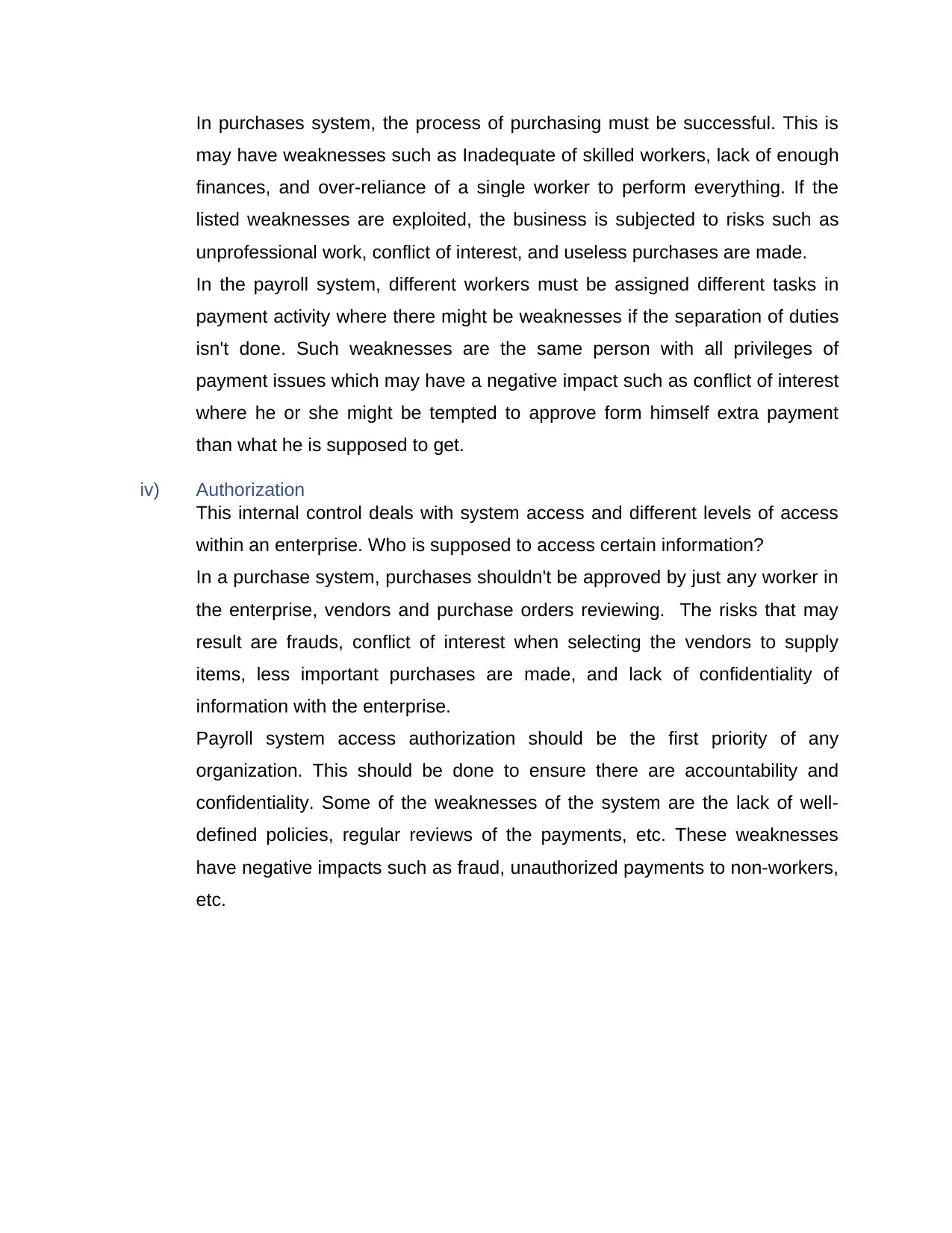
In purchases system, the process of purchasing must be successful. This is
may have weaknesses such as Inadequate of skilled workers, lack of enough
finances, and over-reliance of a single worker to perform everything. If the
listed weaknesses are exploited, the business is subjected to risks such as
unprofessional work, conflict of interest, and useless purchases are made.
In the payroll system, different workers must be assigned different tasks in
payment activity where there might be weaknesses if the separation of duties
isn't done. Such weaknesses are the same person with all privileges of
payment issues which may have a negative impact such as conflict of interest
where he or she might be tempted to approve form himself extra payment
than what he is supposed to get.
iv) Authorization
This internal control deals with system access and different levels of access
within an enterprise. Who is supposed to access certain information?
In a purchase system, purchases shouldn't be approved by just any worker in
the enterprise, vendors and purchase orders reviewing. The risks that may
result are frauds, conflict of interest when selecting the vendors to supply
items, less important purchases are made, and lack of confidentiality of
information with the enterprise.
Payroll system access authorization should be the first priority of any
organization. This should be done to ensure there are accountability and
confidentiality. Some of the weaknesses of the system are the lack of well-
defined policies, regular reviews of the payments, etc. These weaknesses
have negative impacts such as fraud, unauthorized payments to non-workers,
etc.
may have weaknesses such as Inadequate of skilled workers, lack of enough
finances, and over-reliance of a single worker to perform everything. If the
listed weaknesses are exploited, the business is subjected to risks such as
unprofessional work, conflict of interest, and useless purchases are made.
In the payroll system, different workers must be assigned different tasks in
payment activity where there might be weaknesses if the separation of duties
isn't done. Such weaknesses are the same person with all privileges of
payment issues which may have a negative impact such as conflict of interest
where he or she might be tempted to approve form himself extra payment
than what he is supposed to get.
iv) Authorization
This internal control deals with system access and different levels of access
within an enterprise. Who is supposed to access certain information?
In a purchase system, purchases shouldn't be approved by just any worker in
the enterprise, vendors and purchase orders reviewing. The risks that may
result are frauds, conflict of interest when selecting the vendors to supply
items, less important purchases are made, and lack of confidentiality of
information with the enterprise.
Payroll system access authorization should be the first priority of any
organization. This should be done to ensure there are accountability and
confidentiality. Some of the weaknesses of the system are the lack of well-
defined policies, regular reviews of the payments, etc. These weaknesses
have negative impacts such as fraud, unauthorized payments to non-workers,
etc.
Secure Best Marks with AI Grader
Need help grading? Try our AI Grader for instant feedback on your assignments.
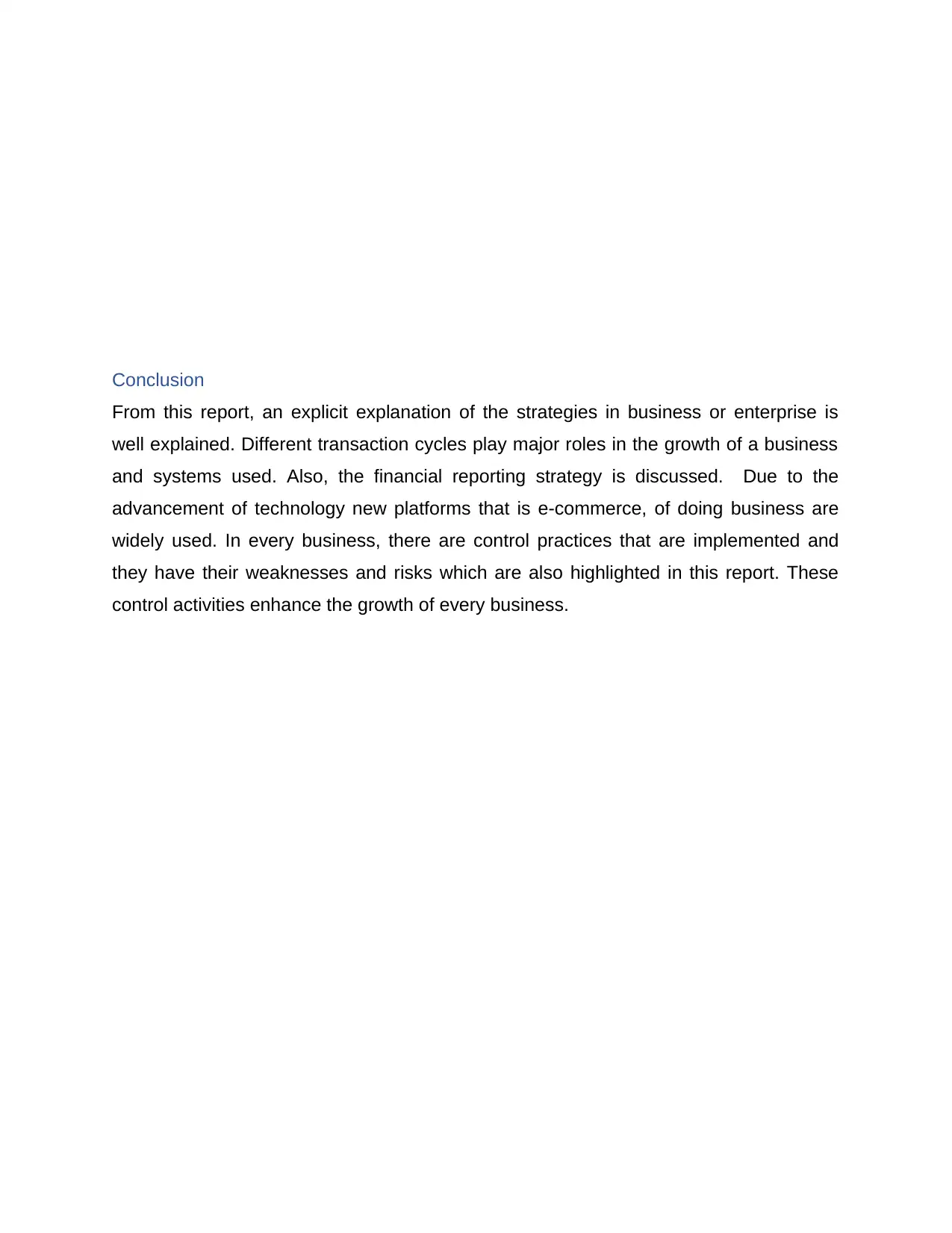
Conclusion
From this report, an explicit explanation of the strategies in business or enterprise is
well explained. Different transaction cycles play major roles in the growth of a business
and systems used. Also, the financial reporting strategy is discussed. Due to the
advancement of technology new platforms that is e-commerce, of doing business are
widely used. In every business, there are control practices that are implemented and
they have their weaknesses and risks which are also highlighted in this report. These
control activities enhance the growth of every business.
From this report, an explicit explanation of the strategies in business or enterprise is
well explained. Different transaction cycles play major roles in the growth of a business
and systems used. Also, the financial reporting strategy is discussed. Due to the
advancement of technology new platforms that is e-commerce, of doing business are
widely used. In every business, there are control practices that are implemented and
they have their weaknesses and risks which are also highlighted in this report. These
control activities enhance the growth of every business.
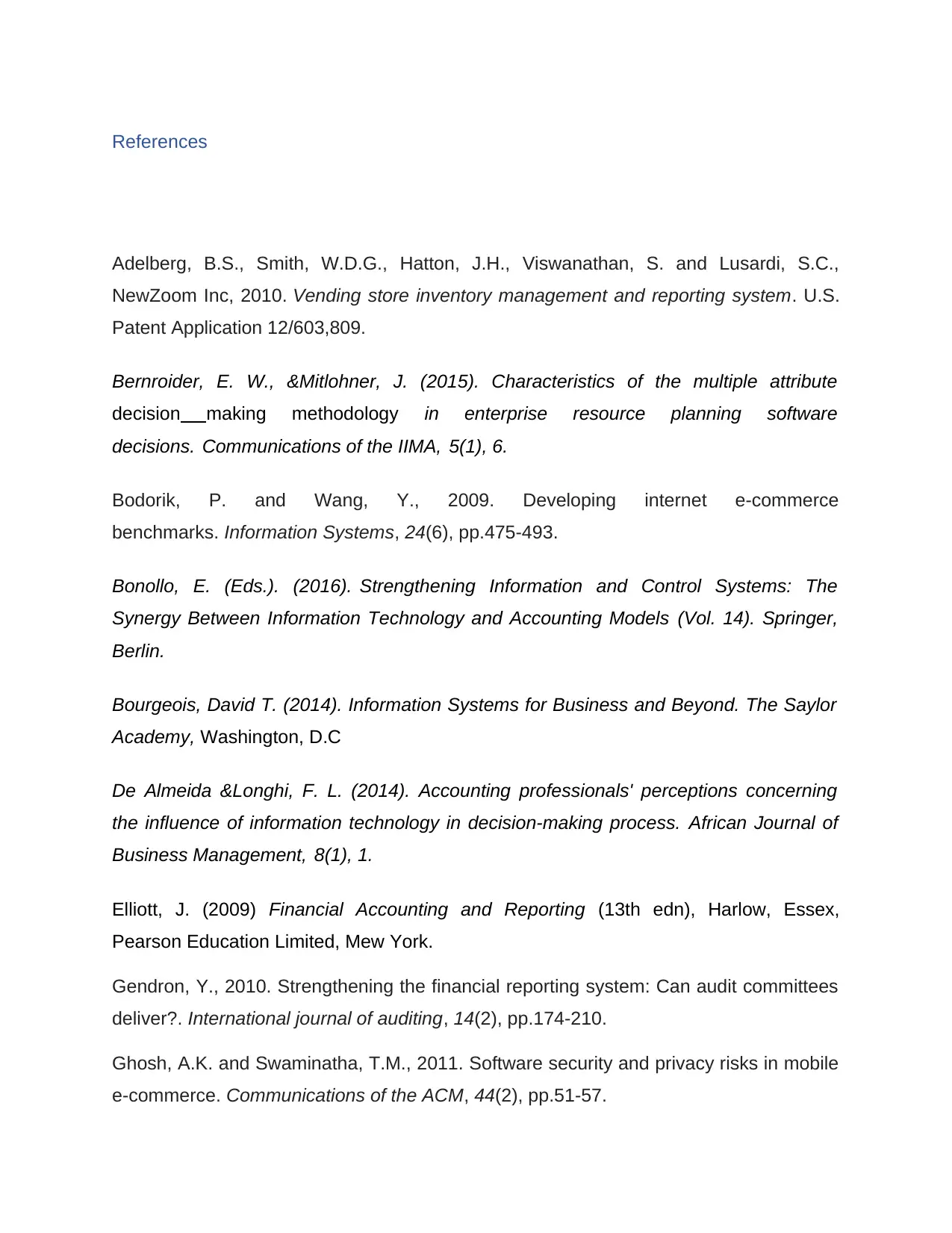
References
Adelberg, B.S., Smith, W.D.G., Hatton, J.H., Viswanathan, S. and Lusardi, S.C.,
NewZoom Inc, 2010. Vending store inventory management and reporting system. U.S.
Patent Application 12/603,809.
Bernroider, E. W., &Mitlohner, J. (2015). Characteristics of the multiple attribute
decision making methodology in enterprise resource planning software
decisions. Communications of the IIMA, 5(1), 6.
Bodorik, P. and Wang, Y., 2009. Developing internet e-commerce
benchmarks. Information Systems, 24(6), pp.475-493.
Bonollo, E. (Eds.). (2016). Strengthening Information and Control Systems: The
Synergy Between Information Technology and Accounting Models (Vol. 14). Springer,
Berlin.
Bourgeois, David T. (2014). Information Systems for Business and Beyond. The Saylor
Academy, Washington, D.C
De Almeida &Longhi, F. L. (2014). Accounting professionals' perceptions concerning
the influence of information technology in decision-making process. African Journal of
Business Management, 8(1), 1.
Elliott, J. (2009) Financial Accounting and Reporting (13th edn), Harlow, Essex,
Pearson Education Limited, Mew York.
Gendron, Y., 2010. Strengthening the financial reporting system: Can audit committees
deliver?. International journal of auditing, 14(2), pp.174-210.
Ghosh, A.K. and Swaminatha, T.M., 2011. Software security and privacy risks in mobile
e-commerce. Communications of the ACM, 44(2), pp.51-57.
Adelberg, B.S., Smith, W.D.G., Hatton, J.H., Viswanathan, S. and Lusardi, S.C.,
NewZoom Inc, 2010. Vending store inventory management and reporting system. U.S.
Patent Application 12/603,809.
Bernroider, E. W., &Mitlohner, J. (2015). Characteristics of the multiple attribute
decision making methodology in enterprise resource planning software
decisions. Communications of the IIMA, 5(1), 6.
Bodorik, P. and Wang, Y., 2009. Developing internet e-commerce
benchmarks. Information Systems, 24(6), pp.475-493.
Bonollo, E. (Eds.). (2016). Strengthening Information and Control Systems: The
Synergy Between Information Technology and Accounting Models (Vol. 14). Springer,
Berlin.
Bourgeois, David T. (2014). Information Systems for Business and Beyond. The Saylor
Academy, Washington, D.C
De Almeida &Longhi, F. L. (2014). Accounting professionals' perceptions concerning
the influence of information technology in decision-making process. African Journal of
Business Management, 8(1), 1.
Elliott, J. (2009) Financial Accounting and Reporting (13th edn), Harlow, Essex,
Pearson Education Limited, Mew York.
Gendron, Y., 2010. Strengthening the financial reporting system: Can audit committees
deliver?. International journal of auditing, 14(2), pp.174-210.
Ghosh, A.K. and Swaminatha, T.M., 2011. Software security and privacy risks in mobile
e-commerce. Communications of the ACM, 44(2), pp.51-57.
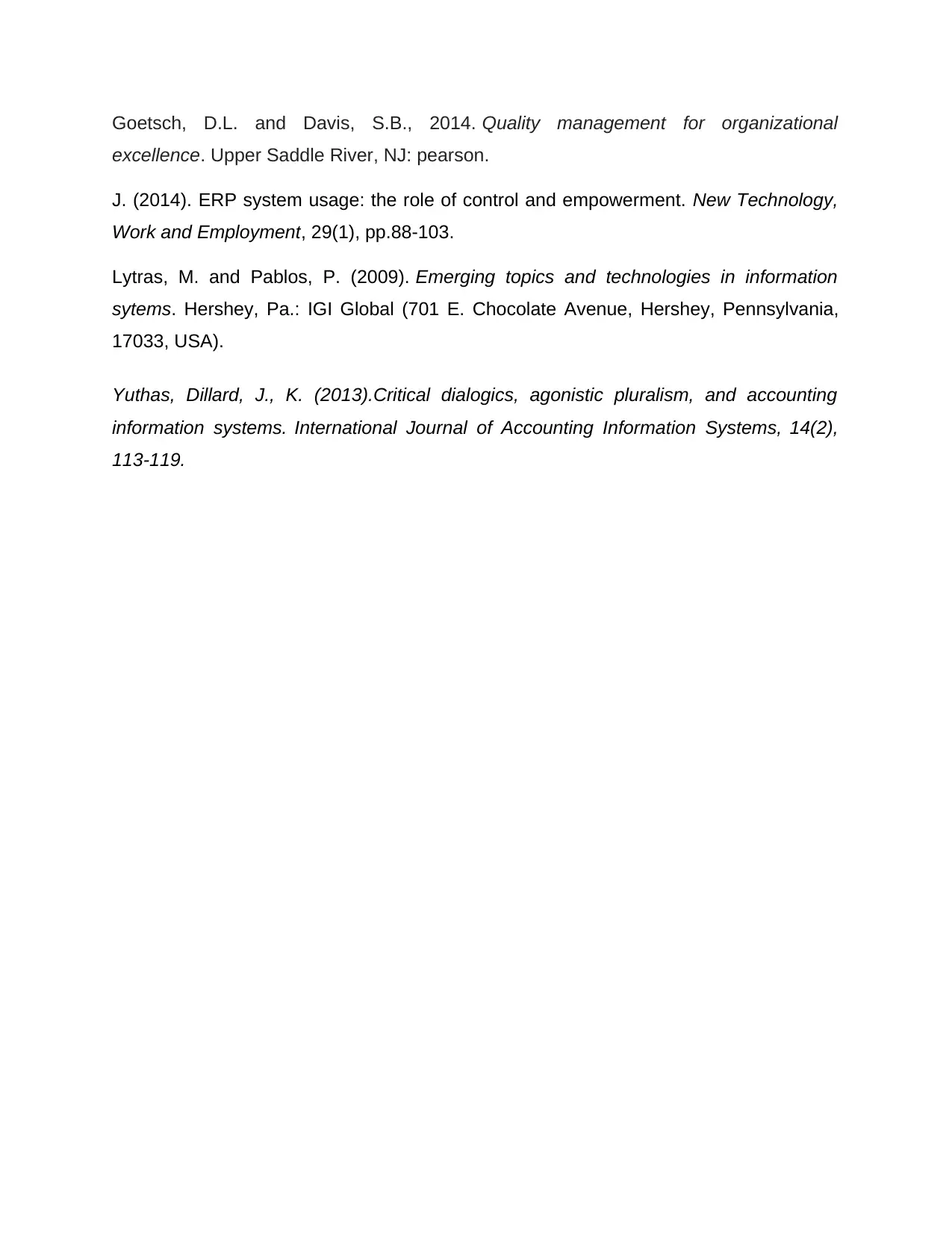
Goetsch, D.L. and Davis, S.B., 2014. Quality management for organizational
excellence. Upper Saddle River, NJ: pearson.
J. (2014). ERP system usage: the role of control and empowerment. New Technology,
Work and Employment, 29(1), pp.88-103.
Lytras, M. and Pablos, P. (2009). Emerging topics and technologies in information
sytems. Hershey, Pa.: IGI Global (701 E. Chocolate Avenue, Hershey, Pennsylvania,
17033, USA).
Yuthas, Dillard, J., K. (2013).Critical dialogics, agonistic pluralism, and accounting
information systems. International Journal of Accounting Information Systems, 14(2),
113-119.
excellence. Upper Saddle River, NJ: pearson.
J. (2014). ERP system usage: the role of control and empowerment. New Technology,
Work and Employment, 29(1), pp.88-103.
Lytras, M. and Pablos, P. (2009). Emerging topics and technologies in information
sytems. Hershey, Pa.: IGI Global (701 E. Chocolate Avenue, Hershey, Pennsylvania,
17033, USA).
Yuthas, Dillard, J., K. (2013).Critical dialogics, agonistic pluralism, and accounting
information systems. International Journal of Accounting Information Systems, 14(2),
113-119.
1 out of 19
Related Documents
Your All-in-One AI-Powered Toolkit for Academic Success.
+13062052269
info@desklib.com
Available 24*7 on WhatsApp / Email
![[object Object]](/_next/static/media/star-bottom.7253800d.svg)
Unlock your academic potential
© 2024 | Zucol Services PVT LTD | All rights reserved.





